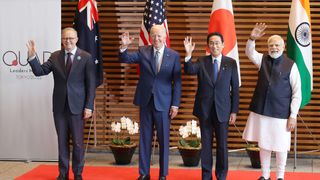Key points
- Maintaining a STEM workforce is a critical but often overlooked component of strengthening national critical technologies capabilities. Many areas require Quad alignment across complex domestic levers such as education, training and skills programs across the talent pipeline.
- Quad countries bring different and potentially complementary strengths to this challenge.
- The research relationships between Quad countries are under-developed, especially when compared to their research partnerships with China.
Policy recommendations
- Quad members should add—and indeed embed—cooperation on STEM workforce issues into their critical and emerging technologies agenda, across diverse pipelines and education and vocational pathways.
- They should create more incentives and infrastructure for joint research, especially on Artificial Intelligence (AI) and cybersecurity.
- This effort should focus on under-developed relationships between Australia, India and Japan rather than these countries' already strong relationships with the United States.
- There is scope to align national skills taxonomies, workforce and centre of excellence mapping so that we have common language and standards for the future technology workforce and can better leverage tech workforces.
A growing gap in talent
There is a global shortage of skilled workers and specifically those in technology and the pipeline for filling these positions is narrowing. One study finds that by 2030, there will be a global human talent shortage of more than 85 million people across all major industries, roughly equivalent to the population of Germany. By 2030 that talent shortage could result in about US$8.5 trillion in unrealised annual revenues. The problem seems acute in the technology sector, although measuring the technology pipeline and workforce is complicated. Not all technology graduates take jobs in the technology industry, and not all those working in the sector are technology graduates.
India is an exception. It is the only country expected to have a surplus of highly skilled financial and business services labour by 2030. India produced a staggering 2.14 million STEM graduates in 2021, and an estimated 800,000 technology graduates across the fields of computer science, IT and maths at all tertiary education levels.
Given their leading role in technology development, it is unsurprising that the United States and Japan have an extensive talent pool of highly skilled and qualified technology workers in a range of fields — from AI to semiconductor manufacturing — and at various stages of technology company growth — from early-stage start-ups to multinational companies.
Australia will have difficulty finding suitably qualified workers, especially with specific technical skills, to meet its growing demand. Australia is predicted to need 1.2 million tech workers by 2030. As at February 2023 its tech workforce stood at 935,000. In 2021 Australia produced 47,764 STEM graduates, of which 12,200 obtained bachelor-level degrees. But 4,800 of these graduates took jobs outside the technology industry. In 2022, the Australian Academy of Technological Sciences and Engineering called for a National Skills Taxonomy to streamline consistent communication about needs and pathways among Australia’s organisations and individuals. The Quad could build on this idea, linking or aligning national skills taxonomies so that we have a common language and standards for the future technology workforce.
Australia needs to diversify as well as grow its tech workforce. One estimate suggests that improving diversity in the technology workforce would grow Australia’s economy by A$3.1 billion on average every year over the first 20 years. This needs to include expansion of consideration to early pipeline, from primary school to PhDs as well as vocational and industry pathways, especially in AI.
Critical and emerging technologies in the Quad
Quad members should add cooperation on STEM workforce issues to their critical and emerging technologies agenda. That agenda recognises the transformative economic, social, and national security impact of these technologies and the need for like-minded countries to shape technological innovation. Thus far, the Quad has focused on semiconductor supply chains, 5G communications and technical standards, such as those for AI. It is horizon-scanning areas such as biotechnology and quantum. Success will require enhanced cooperation on innovative technologies and international standards.
The STEM workforce — and the pipeline for future workforce — is a critical, but often overlooked, component of this agenda. Quad countries bring different capabilities to this challenge. Australia has a robust, high-skilled and innovative workforce and highly developed digital economy. Japan is a global leader in robotics, automation, and the commercialisation of technology breakthroughs. India has a massive technology talent pool, and the United States is investing heavily in emerging technologies across the board — from the AI workforce to greater resources for research and development and bolstering domestic chips production. Last year the Australian Academy of Technological Sciences & Engineering called for a National Skills Taxonomy to streamline consistent communication about needs and pathways among Australia’s organisations and individuals, and alignment across Quad nations would help leverage existing and future workforces.
Quad countries should combine their respective knowledge, equipment, and resources where possible. The STEM–focused Quad Fellowship program, announced in 2022, has seen the sponsorship and convening of 100 leading postgraduate students across the four countries. This is an excellent initiative but Quad countries should build on it to strengthen people-to-people relationships and build trusted professional networks. They should also make policy and regulatory adjustments and align educational and industry technology research and development. The Quad could serve as a natural incubator for cutting-edge innovation on a regional and global scale.
Potential for technology workforce collaboration on AI
AI provides one example of the benefits the Quad could accrue by cooperating on workforce issues. The four Quad countries are among the top ten producers of AI research in the world, both by number of research publications and citations. Collectively, researchers in the Quad countries generated nearly 650,000 AI-related research papers between 2010 and 2020. This is more than the combined output of European Union and Association of Southeast Asian Nations (ASEAN) researchers. "Japan stands out in simulation and human-computer interaction (HCI), India in data mining and data science, Australia in linguistics and theoretical computer science, and the United States in machine learning and natural language processing." These strengths could be leveraged by creating more incentives and infrastructure for joint research.
There is real potential to improve personal and institutional relationships and incentivise AI-related research between the Quad countries. The United States collaborates extensively with Australia, India, and Japan on AI-related research; however, the latter three collaborate far less with one another. Meanwhile, China is the top research partner for the United States and is the second leading partner for the rest of the Quad members. US research cooperation with China outweighs its research cooperation with the rest of its Quad partners taken together. Australia, India, and Japan also each have more research partnerships with China than they do with one another. Improving institutional relationships, collaborative funding incentives and streamlining migration for various methods of study, research and collaboration across the Quad countries are a good early area of focus.
Georgetown University’s Centre for Security and Emerging Technology has suggested several ways for government, universities, research institutions, and private sector partners to support AI-related research collaboration between Australia, India, and Japan. These include grants for joint research projects, scholarships and fellowships for visiting researchers and academic exchanges, competitions and prizes for jointly developed prototypes and solutions as well as conferences and workshops.
The prospects for Quad success hinge on building stronger ties among the members beyond their bilateral linkages to the United States. The Quad members each have something to offer — and have similar goals — when it comes to critical and emerging technologies and creating workforce solutions, innovation ecosystems and exchange between the four nations. When it comes to technology workforce we need not develop the habit of collaboration, but embed the habits of collaboration and cooperation.






